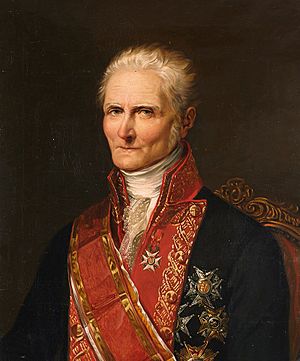Joaquín de la Pezuela, 1st Marquess of Viluma facts for kids
Quick facts for kids
The Most Excellent
The Marquess of Viluma
|
|
|---|---|

Portrait as Captain general of New Castile, 1825
|
|
| 39th Viceroy of Peru | |
| In office July 7, 1816 – January 29, 1821 |
|
| Monarch | Ferdinand VII |
| Preceded by | José Fernando de Abascal |
| Succeeded by | José de la Serna |
| Personal details | |
| Born | May 21, 1761 Naval, Huesca, Spain |
| Died | 1830 Madrid, Spain |
| Profession | Military |
| Signature | |
| Military service | |
| Allegiance | |
| Rank | Lieutenant General |
| Battles/wars | Spanish American wars of independence |
Joaquín de la Pezuela (born May 21, 1761 – died 1830) was a Spanish army officer. He became the viceroy of Peru. This was during the time when Peru was fighting for its independence from Spain. He was also known as the 1st Marquess of Viluma.
Contents
Early Life and Military Career
Joaquín de la Pezuela was born in Spain in 1761. His family was part of the lower nobility, called hidalgo. He studied at the Artillery College in Segovia, learning about cannons and military weapons.
As a young officer, he fought in important battles. He was part of the Great Siege of Gibraltar, a long fight for control of the fortress. Later, he fought against French forces in Spain in the 1790s.
In 1805, Pezuela moved to America. He became a military leader in a region called Alto Perú, which is now Bolivia. From there, he went to Peru. The viceroy of Peru, José Fernando de Abascal y Sousa, made him the director of the Royal Artillery. Pezuela worked hard to improve the artillery. He focused on making it more modern and technically advanced. In 1813, he was promoted to brigadier, a high rank in the army.
Viceroy of Peru
Pezuela was a strong supporter of the Spanish King in South America. He fought against the groups who wanted independence. These groups were called insurgents.
In 1813, he won two important battles against Manuel Belgrano. These were the Battle of Vilcapugio on October 19 and the Battle of Ayohuma on November 14. Both battles took place in what is now Bolivia. After these wins, Pezuela's army moved south. They took control of Jujuy in northern Argentina in May 1814. Then they captured Salta in July 1814.
However, Pezuela's forces faced constant attacks. General Martín Miguel de Güemes and his gaucho fighters kept bothering them. Pezuela had to retreat back to Jujuy. He lost 1,200 men during this retreat, even without fighting a major battle.
In 1815, Pezuela fought against José Rondeau. He defeated Rondeau in the Battle of Sipe-Sipe, also known as Viluma. This battle happened on November 29, 1815, near Cochabamba in Alto Perú. It was a very big defeat for the independence fighters. They lost 2,000 men and all their cannons.
Because of his success, Pezuela was promoted in 1816. He became a lieutenant general. He also received the special title of Marqués de Viluma. The King of Spain then named him the new viceroy of Peru. He took over from Viceroy Abascal. The next year, he also became the captain general of Peru, which meant he was the top military commander.
In 1819, a British naval officer named Thomas Cochrane attacked Callao, a port in Peru. Pezuela was forced to leave the port.
A Change in Leadership
Viceroy de la Pezuela had disagreements with his second-in-command, Lieutenant General José de la Serna. Pezuela believed in absolute rule by the king. De la Serna, however, had more liberal ideas.
Because of these differences, de la Serna asked to leave his post and return to Spain. He received permission in May 1819. In September, de la Serna gave up his command of the army to General José Canterac.
However, de la Serna had many supporters in Lima. When he arrived there, they protested. They wanted him to stay in Peru. They felt he was needed to defend against a possible invasion by General José de San Martín from Chile. Pezuela agreed to promote de la Serna. He also made him president of a war council.
General San Martín landed in Pisco on September 8, 1820. De la Serna was secretly made commander-in-chief of the army. This army was gathered at Aznapuquio to protect the capital city from San Martín.
On January 29, 1821, the main officers of the army, who supported de la Serna, asked Viceroy de la Pezuela to step down. They wanted de la Serna to become the new viceroy. Pezuela refused. He ordered de la Serna to stop the rebellion among the officers. But de la Serna said he could not control them. Pezuela saw that he had lost his authority. So, on the evening of the same day, he handed over his power. Later, the King of Spain accepted this change in leadership.
Later Life
Pezuela returned to Spain in 1825. There, he became the captain general of New Castile, a region in Spain. He passed away in Madrid in 1830.
His family continued to be important. His oldest son was Manuel de la Pezuela, 2nd Marquess of Viluma. His second son was Juan de la Pezuela y Cevallos. His nephew, Manuel de la Pezuela y Lobo-Cabrilla, was a politician. He served as a minister in the Spanish government. He also helped develop new ideas for naval ships, like the torpedo gunboat. This led to the creation of the Destructor, a ship that was a very early version of modern destroyers. He also supported the funding for Isaac Peral's project to build an electric-powered submarine, which was the first of its kind.
Images for kids
See also

